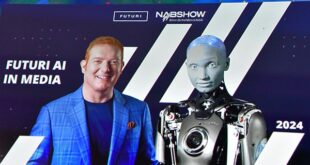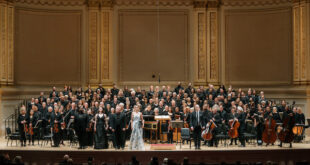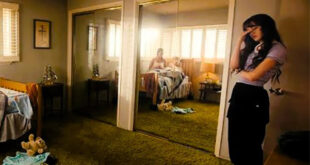Even if you’re a rabid Beatles fan (and who isn’t?), you may think you’ve seen enough movies related to the group to last a lifetime. Over the past half-century or so, the Fab Four have figured in everything from musical comedies like A Hard Day’s Night and Help to the animated Yellow Submarine to documentaries such as The Compleat Beatles, the five-DVD Anthology, and Ron Howard’s Eight Days a Week. Even if you’ve seen all these films, though, you’ve never experienced anything like Get Back, the 2021 Disney documentary that is finally being released (after multiple delays) as a three-disc Blu-ray set with Dolby Atmos audio.
Directed and produced by filmmaker Peter Jackson (best known for the Lord of the Rings and Hobbit movies), this nearly eight-hour gem bears the same title as a 1970 documentary about the making of the album Let It Be but tells a much more nuanced and in-depth story. It does so via material culled from about 60 hours of unseen video and 150 hours of unheard audio captured for the earlier movie by Michael Lindsay-Hogg. The new film takes us inside the Beatles’ creative process as they concoct an LP from scratch while also preparing for their first live performance in nearly two and a half years.
Disc One opens with a scene-setting crash course in Fab Four history. In approximately 10 minutes, we get flashes of the Quarrymen; the pre-fame Hamburg, Germany shows; the hookup with Brian Epstein; the historic Ed Sullivan Show appearances; the Beatle movies; the Shea Stadium concert; the bigger-than-Jesus controversy; Epstein’s death; the sojourn to India to see the Maharishi; the launch of Apple Corps; and more…all leading up to the decision to write and rehearse new songs for a TV special and album in January 1969. The rest of the first disc, all of the second, and the beginning of the third let you be a fly on the wall—first at Twickenham Film Studios and then at Apple’s own facilities—as the Beatles work through their issues, play with ideas, and develop material for Let It Be, their last album (though the sessions mostly predated those for Abbey Road, which was issued earlier).
Director Jackson wisely eschews any attempt at narration. Instead, words on the screen unobtrusively identify songs and their composers and spell out dialogue that might be hard to decipher. Also identified by captions are the many Beatles-associated people who come in and out, including Yoko Ono, who spends a lot of time knitting; Linda Eastman, who snaps photos of the boys; Linda’s six-year-old daughter, Heather, who dances around and seems to charm everyone; producer George Martin; George Harrison’s wife, Pattie Boyd, and a Hare Krishna friend of his; actor Peter Sellers; recording engineer Glyn Johns; Apple press officer Derek Taylor; and Beatles film producer Dennis O’Dell.
Dozens and Dozens of Songs
Throughout these sessions, the Fab Four deliver snippets from dozens upon dozens of songs. There are, of course, early versions of the numbers that wound up on the Let It Be album, including “For You Blue,” “I Dig a Pony,” “Maggie Mae,” “Don’t Let Me Down,” and “The Long and Winding Road.” Also: “One After 909,” which John Lennon says he wrote when he was about 15; Harrison’s “I Me Mine,” which he sings while Lennon and Ono dance; and multiple versions of “Get Back,” among them one with lyrics that condemn white nationalism and another that incorporates lines from the Four Tops’ “Reach Out (I’ll Be There).” But these Let It Be warmups are just for starters.
Also here are portions of many songs from the Beatles’ catalog, including camped-up versions of “Help!” and “Please Please Me”; a countrified “Love Me Do”; Harrison’s “Old Brown Shoe,” with him on piano; and numbers from the forthcoming Abbey Road, among them Ringo’s “Octopus’s Garden” with him on piano and George on guitar; and an embryonic “Something.” The sessions additionally incorporate material that would show up on 1970s solo albums, such as Harrison’s “All Things Must Pass,” Lennon’s now-more-relevant-than-ever “Gimme Some Truth,” and Paul McCartney’s “Just Another Day.”
On top of all that, there are more than enough covers of early rock, country, and R&B songs to remind you just how acquainted with and indebted to this music the Beatles were. They offer bits of Chuck Berry’s “Johnny B. Goode,” “Forty Days,” “School Days,” and “Rock and Roll Music” (the latter intercut here with a film clip of the Beatles performing the song in concert in the mid-’60s); Big Joe Turner’s “Honey Hush”; Bill Haley’s “Shake, Rattle, and Roll”; Roy Brown’s “Good Rockin’ Tonight”; Carl Perkins’s “Blue Suede Shoes”; Bobby Darin’s “Queen of the Hop”; Gary U.S. Bonds’s “New Orleans”; Wilbert Harrison’s “Kansas City”; Arthur Crudup’s “My Baby Left Me”; the Isley Brothers’ “Shout”; Ben E. King’s “Stand by Me,” which Lennon would later record for Rock ‘n’ Roll, his covers LP; ” Little Richard’s “Miss Ann”; the Drifters’ “Save the Last Dance for Me”; Tommy Tucker’s “Hi-Heel Sneakers,” Eddie Cochran’s “Twenty-flight Rock”; and the Everly Brothers’ “Bye Bye Love.”
Here, too, are bits of Bob Dylan’s “Mama, You Been on My Mind” and “I Shall Be Released”; Hank Williams’s “Take These Chains from My Heart” and “You Win Again,” the latter in a tongue-in-cheek version sung by Lennon; Emile Ford’s “Why Do You Want to Make Those Eyes at Me For”; Ray Charles’s “Hallelujah I Love Her So”; Canned Heat’s “Going Up the Country”; “Woman,” the McCartney-penned Peter & Gordon hit; and the traditional “House of the Rising Sun” and “Midnight Special.”
Fascinating Conversation
Watching and hearing the Beatles run through all this material is a fascinating experience but their conversations are no less interesting than the music. Under pressure to come up with new material, they note nervously at one point that while only 12 days remain until their planned live show, they have just a few songs ready. They talk about perhaps canceling the performance and of doing it with or without an audience. They also discuss a wide range of possible venues, including a farm, a boat, a hospital, an orphanage, a ballroom, the House of Parliament, and even an open-air stadium in the ancient Libyan city of Sabratha.
After keyboardist Billy Preston arrives to say hello and winds up adding keyboards on seven of Let It Be’s 12 tracks, the group talk about making him the fifth Beatle. George comments that he previously asked Bob Dylan to join the group and McCartney quips that “it’s bad enough with four.” Elsewhere, they reminisce about their trip to see the Maharishi in India and talk about how their feuds will be viewed in 50 years. At one point, John gleefully announces that Yoko’s divorce just went through. He also raves about manager Allen Klein (“an incredible guy”), but engineer Glyn Johns seems skeptical of him. Paul, meanwhile, talks about getting over “the nervousness of playing to an audience.”
The story for decades has been that these are the sessions when the Beatles fell apart, and there’s certainly plenty of evidence here to back that up. They talk of a possible “divorce” and lament the death of Epstein, who they agree gave them a sense of discipline that is now lacking. Harrison says, “The Beatles have been in doldrums for at least a year,” and tension is particularly high between him and Paul.
At one point, George comments offhandedly that it’d be nice to do an album on his own; at another, he responds to an instruction from McCartney with “Whatever it is that will please you, I’ll do it.” Finally, near the end of Part One of the film, an exasperated Harrison abruptly announces, “I’m leaving the band now,” adding “get a replacement” and “see you ’round the clubs.” Says Lennon nonchalantly: “If he doesn’t come back by Tuesday, we get [Eric] Clapton.” Later, though, he and McCartney sound more concerned as they discuss what to do about Harrison’s departure in a conversation captured by a hidden microphone.
Moments of Joy
The situation turns out to be more complicated than scenes like this make it seem, however, because the signs of discord are interspersed with many moments of pure joy as all four members of the group rediscover the pleasure of one another’s company and the thrill of making music together. Lennon and McCartney affectionately revisit obscure and frequently charming songs they wrote when they were starting out, such as “Just Fun,” “Because I Know You Love Me So,” “Fancy My Chances with You,” and “Too Bad About Sorrow.” Also: McCartney’s “I Lost My Little Girl,” which was the first song he ever wrote (he was 14); and Lennon’s “On the Road to Marrakesh,” which sounds like an early version of Imagine’s “Jealous Guy.”
The four clown around, play one another’s instruments, and read news articles about the Beatles out loud and laugh. There are many times when John and Paul in particular share smiles and jokes, affect accents, sing “Two of Us” through gritted teeth for laughs, and seem entirely in sync musically. At one point, McCartney plays piano as Ringo tap dances, and George and Paul both play drums at various times. For one song, Yoko puts down her knitting and sings lead. John dances with her at several points; he also dances with Paul.
Say Ringo: “Don’t assume it’s our last TV show just because we’ve got a bit grumpy.” Indeed, all is not lost, at least not yet: after John, Paul, and Ringo meet twice with George, he returns to the group near the beginning of Part Two of this series, and they start recording in a basement studio at Apple.
As Part Three begins, only three days remain until the scheduled (but unannounced) Jan. 30, 1969 rooftop concert above Apple’s offices on London’s Saville Row. Even in the hours before it, the four are still discussing whether to do it. But they do, and with gusto, and the entire performance appears here for the first time in its entirety.
Mixed Reactions on the Streets
Down on the streets, where cameras have been placed, the public seems divided. An interviewer talks to pedestrians, many of whom seem delighted by the surprise concert and say things like “I’m all in favor of it!” But one man says it “absolutely disrupts all the business in this area” while a woman gripes that “it woke me up from my sleep and I don’t like it!” Then the police show up, say that “we’ve had 30 complaints of noise within minutes” and demand that the performance end or they’ll start arresting people for disturbing the peace.
The Beatles—whose associates do their best to stall the authorities—manage to get through five songs (several of them more than once) before the cops work their way up to the roof. When the bobbies finally arrive there, the Beatles wrap up a take of “Get Back” with McCartney ad-libbing about how playing on a roof will get you arrested. Then they head downstairs to listen to a playback of the tape.
Before they do, Lennon famously calls out, “I would like to say thank you on behalf of the group and ourselves and I hope we’ve passed the audition.” Yes, you have, John. As for the cops who tried to shut down the first Beatles concert in years—which also turned out to be the last gig ever by this legendary group—well, as far as yours truly is concerned, they flunked their audition.
 Blogcritics The critical lens on today's culture & entertainment
Blogcritics The critical lens on today's culture & entertainment




